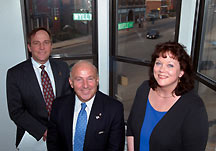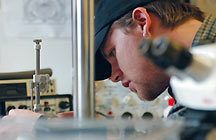The BEACON consortium
Creating partnerships and educational opportunities in biomedical
engineering
by Michael Bradley ’98
| |
|
 |
|
Beacon staff
members Jeff
Horn,
industrial
liaison
officer;
Joseph
Bronzino,
director;
and Jane
Mussehl,
program
coordinator
photo: Nick
Lacy |
|
| |
|
Could Hartford some day be to biomedical engineering what
Silicon Valley is to the computing industry? Joseph Bronzino
believes so, and the Vernon Roosa Professor of Applied Science
and President of the Biological Engineering Alliance and
Consortium (known as BEACON) hopes to see that it becomes a
reality in the near future.
Founded initially in 1997 with funding from the Whitaker
Foundation, BEACON has evolved to become an alliance of academic,
medical, and corporate organizations dedicated to the development
of new medical technology. BEACON pools the talents and resources
of Trinity and other academic institutions, including the
University of Hartford, the University of Connecticut, and the
University of Connecticut Health Center, the University of
Massachusetts at Amherst, Springfield Technical Community
College, and, most recently, Drexel University, as well as
medical institutions such as Hartford Hospital, the Yale-New
Haven Hospital, John Dempsey Hospital, the Baystate Health
System, and Saint Francis Hospital. Since its inception, BEACON
has attracted a veritable who’s who of the region’s
most prominent biomedical engineering companies, including Boston
Scientific, Connecticut Light & Power, Pfizer, GE Medical
Systems, and Tyco Healthcare.
“Our objectives are to stimulate collaborative research,
encourage industrial partnering so that academics and industry
can work together on specific projects, and facilitate the
development of new incubating companies to take ideas that may
exist on the campus and make them realizable as commercial
products,” Bronzino says.
Prior to the consortium’s inception in 1997, Bronzino
approached the presidents of Trinity College, the University of
Hartford, the University of Connecticut, and the University of
Connecticut Health Center and suggested that the institutions
would benefit from pooling their strengths in biomedical
engineering. He received permission to proceed from Trinity’s
former president, Evan Dobelle, and the other presidents, and
quickly assembled a task force drawn from the prospective
consortium institutions. Backed by a $1-million grant from the
Whitaker Foundation, Bronzino and the fledgling BEACON group set
out to achieve the goals funded by the grant. These included
integrating the educational opportunities in bioengineering for
students in the region; hiring additional faculty in
biomechanics, biosensors, and bioinstrumentation; and
facilitating medical technology transfer within Connecticut.
Since that time, BEACON has grown from a small educational
consortium to a multipronged alliance of corporations, medical
facilities, and academic institutions that spans the so-called
“Knowledge Corridor” between North Hampton and New
Haven and, as a result, a sizable area of New England.
Creating educational opportunities for Trinity students
Through the BEACON consortium, Trinity students can take
specialized courses at member institutions such as the University
of Connecticut Health Center and receive credits toward their
Trinity degree. Bronzino says BEACON has provided a variety of
other opportunities for Trinity students to gain experience that
may give them an edge in planning for a career in biomedical
engineering.
According to Bronzino, “Trinity students have the
opportunity to get involved with research projects of the
biomedical faculty at the UConn Health Center as well as St.
Francis and Hartford Hospital. They also may take advantage of
the annual BEACON symposia and tech fair, which occurs each fall,
thereby stimulating their intellectual interest in the fields of
bioscience and bioengineering.”
| |
 |
| |
"At a BEACON
symposium
last fall, I
was able to
present
research I
had done in
the lab
during the
year and
over the
summer to
experts in
the field."
Josh
Griffis'03
photo: Nick
Lacy |
| |
|
Josh Griffis ’03, has participated since his junior year,
attending events and enrolling in courses at the University of
Connecticut Health Center. Griffis, a double major in biomedical
engineering and electrical engineering, says that exposure is one
of the best things he has gotten from BEACON.
“I’ve had a chance to see so many different topics and
so many different presenters that I’ve been able to broaden
my range of interests and pinpoint what I want to do in the
future. At a BEACON symposium last fall, I was able to present
research I had done in the lab during the year and over the
summer to experts in the field.” Griffis says he is
intrigued by developments in the area of stem cell research and
has applied to graduate schools, where he plans to study
neuroengineering.
“At Trinity, undergraduates also have an opportunity to see
research and development turning into a commercial product,”
Bronzino says. “It’s an education on how to transfer
ideas and creativity into the marketplace, where they can
eventually have a much larger impact on the quality of our lives,
and, in the process, create jobs. In a large university, the only
ones who experience this are graduate students.”
While students benefit from their enhanced access to businesses
and educational institutions, member corporations may also turn
to BEACON’s network of academic talent to obtain expert
evaluations of upcoming products. “In industry, time is
money,” Bronzino says. “At BEACON we can quickly refer
companies to experts in whatever field they’re looking for.”
He hopes to see BEACON continue to enrich the biomedical research
community and, by extension, to create new jobs. “Our main
focus is Hartford and the ‘Knowledge Corridor.’ There
is no doubt that Hartford can become a center for medical device
and system development, making it an economic engine for the
region.”
Bronzino expects BEACON to be a continued presence in brokering
collaboration among academia, industry, and medical institutions
in the future.
“We’re making people more aware of our activities, so
we can create an environment that is essential for the creation
of jobs in this area,” he says. “We are establishing an
opportunity for continued enrichment of bioscience and biomedical
engineering in the region of Greater Hartford and the Northeast.
We are continually stirring the pot to form relationships and
partnerships that will enhance the creative process.”
back to top |